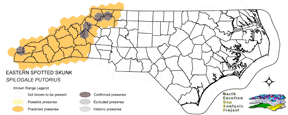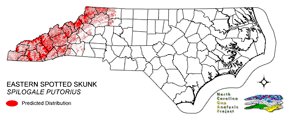
| Taxa: |
| Order: |
| Family: |
| Mammalia |
| Carnivora |
| Mustelidae |
| NatureServe Global Rank: |
| NatureServe State (NC) Rank: |
| G5 |
| S3S4 |
| Federal Status: |
| NC State Status: |
| --- |
| --- |


| Land Unit |
| US Fish & Wildlife Service |
| US Forest Service |
| US National Park Service |
| US Department of Defense |
| NC State Parks |
| NC University System |
| NC Wildlife Res. Com. |
| NC Forest Service |
| NC Div. of Coastal Mgmt. |
| Local Governments |
| Non-Governmental Org. |
| Other Public Lands |
| Private Lands |
| GAP Status 1-2 |
| All Protected Lands |
| Statewide |
| Hectares |
| 0.00 |
| 206,289.45 |
| 37.08 |
| 83,774.88 |
| 3,100.23 |
| 70.20 |
| 4,415.58 |
| 893.13 |
| 0.00 |
| 5,151.51 |
| 5,568.48 |
| 123.57 |
| 759,340.80 |
| 117,193.38 |
| 309,090.93 |
| 1,068,764.91 |
| Acres |
| 0.00 |
| 509,752.23 |
| 91.63 |
| 207,012.20 |
| 7,660.83 |
| 173.47 |
| 10,911.13 |
| 3,156.00 |
| 0.00 |
| 12,729.66 |
| 13,760.01 |
| 305.35 |
| 1,876,371.61 |
| 290,540.13 |
| 764,729.21 |
| 2,641,924.13 |
| % of Dist. on |
| Prot. Lands |
| 0.0 % |
| 66.7 % |
| < 0.1 % |
| 27.1 % |
| 1.0 % |
| < 0.1 % |
| 1.4 % |
| 0.3 % |
| 0.0 % |
| 1.7 % |
| 1.7 % |
| < 0.1 % |
| 0.0 % |
| 37.9 % |
| ----- |
| ----- |
| % of Dist. on |
| All Lands |
| 0.0 % |
| 19.3 % |
| < 0.1 % |
| 7.8 % |
| 0.3 % |
| < 0.1 % |
| 0.4 % |
| < 0.1 % |
| 0.0 % |
| 0.5 % |
| 0.5 % |
| < 0.1 % |
| 71.0 % |
| 11.0 % |
| ----- |
| ----- |
|
In western North Carolina, the spotted skunk is a relatively common denizen of mountain slopes and valleys above river floodplains (Lee et al. 1982). South of the Appalachians, it is known as an inhabitor of farm country, perhaps being most abundant in farmlands with a mix of cultivated and fallow fields and with nearby woodlots (Brown 1997, Whitaker and Hamilton 1998). However, in some regions, brushy and rocky areas in both open and wooded situations may also be used. In fact, in western North Carolina, some sources indicate its primary habitat may be in open forests at all elevations where talus, cliffs, and other rocky sites provide ample shelter (Lee et al. 1982, Webster et al. 1985). Conversely, Linzey and Linzey (1971) describes this skunk as essentially restricted to valleys and lower slopes. Not typically found in large expanses of dense forest or near bottomland wet sites (Whitaker and Hamilton 1998). NATURE SERVE GLOBAL HABITAT COMMENTS: Open and brushy areas, rocky canyons and outcrops in woodlands and prairies. When inactive or bearing young, occupies den in burrow abandoned by other mammal, under brushpile, in hollow log or tree, in rock crevice, under building, or in similar protected site. |
| Code | Name | Description | NC Natural Heritage Program Equivalent |
| 180 | Agricultural Crop Fields | Farm fields used for row crops. | No equivalent |
| 205 | Agricultural Pasture/Hay and Natural Herbaceous | Farm fields used for pasture grass or hay production, as well as old fields dominated by native and exotic grasses. | No equivalent |
| 202 | Residential Urban | Includes vegetation interspersed in residential areas. Includes lawns, mixed species woodlots, and horticultural shrubs. Vegetation accounts for between 20 - 70% of the cover. | No equivalent |
| 521 | Spruce/Fir Forest | High Elevation Frazer-Fir - Red Spruce, Red Spruce and Red-Spruce-Yellow Birch Forests. Tree densities included here include both woodland to forest density. Highly intermixed with Northern Hardwoods, Grassy Balds, and Shrub Balds. | Red Spruce--Fraser Fir Forest, Fraser Fir Forest |
| 522 | Northern Hardwoods | High Elevation forests including yellow birch, American beech, and yellow buckeye. Includes forests with Hemlock and Yellow Birch. | Northern Hardwoods Forest, Boulderfield Forest |
| 525 | Appalachian Oak Forest | A variety of oak forest types including Black, White, Scarlet Oaks in dry to mesic situations. Includes forests historically co-dominated by American Chestnut. | High Elevation Red Oak Forest, Montane White Oak Forest |
| 526 | Appalachian Cove Forest | Mixed Mesophytic forests of the mountains. Includes tuliptree, basswood, yellow buckeye and surgar maple. This class is mapped to include cove forests dominated or co-dominated by hemlock. | Rich Cove Forest, Acidic Cove Forest |
| 527 | Appalachian Hemlock | Upland hemlock forests of the moutains region. Vary from side slopes to steep slope positions. | Canada Hemlock Forest |
| 528 | Appalachian Xeric Pine Forest | Pine forests and woodlands on xeric sites. A variety of pines, including Virginia, Shortleaf, Eastern White Pine, Table Mountain and Pitch pine. Often small areas of dense pine within a matrix of Xeric Oak-Pine Forests. | Pine Oak Heath |
| 529 | Appalachian Xeric Mixed Forest | Mixed forests with Virginia, Shortleaf, Eastern White Pine, Table Mountain and Pitch pines in combination with xeric oak species. Oaks include, white, Southern Red, black, and rock chestnut. | Pine Oak Heath |
| 530 | Appalachian Xeric Deciduous Forest | Deciduous forests in the mountains dominated by Xeric Oak species. Species include, white, Southern red, black, and rock chestnut. | High Elevation Red Oak Forest, Montane White Oak Forest |
| 535 | Talus/Outcrops/Cliffs | Includes seep talus slopes with sparce vegetation, as well as outcrops including, granitic outcrops. Some outcrops will have been mapped as barren rock. | No equivalent |
|
Mead, R. A. 1968. Reproduction in western forms of the spotted skunk (genus SPILOGALE). J. Mamm. 49:373-390.
Howard, W. E., and R. E. Marsh. 1982. Spotted and hog-nosed skunks. Pages 664-673 in J. A. Chapman and G. A. Feldhamer, editors. Wild mammals of North America:biology, management, and economics. Johns Hopkins University Press, Baltimore. xiii + 1147 pp. Howell, A. H. 1906. Revision of the skunks of the genus Spilogale. North American Fauna 26:1-55. Jones, J. K., Jr., et al. 1992. Revised checklist of North American mammals north of Mexico, 1991. Occas. Pap. Mus., Texas Tech Univ. (146):1-23. Wilson, D. E., and D. M. Reeder (editors). 1993. Mammal Species of the World:a Taxonomic and Geographic Reference. Second Edition. Smithsonian Institution Press, Washington, DC. xviii + 1206 pp. Brown, L. N. 1997. A guide to the mammals of the southeastern United States. University of Tennessee Press, Knoxville. xiv + 236 pp. Crabb, W.D. 1948. The ecology and management of the prairie spotted skunk in Iowa. Ecol. Manag. 18:201-232. Whitaker, J.O. Jr. and W.J. Hamilton, Jr. 1998. Mammals of the eastern United States. Cornell Univ. Press, Ithaca, New York. 583 pp. Lowery, G. H., Jr. 1974. The mammals of Louisiana and its adjacent waters. Louisiana State University Press, Baton Rouge. 565 pp. Van Gelder, R. G. 1959. A taxonomic revision of the spotted skunks (genus SPILOGALE). Bull. Am. Mus. Nat. Hist. 117:229-392. Lee, D. S., L. B. Funderburg Jr., and M. K. Clark. 1982. A distributional survey of North Carolina mammals. Occasional Papers of the North Carolina Biological Survey, No. 1982-10. North Carolina State. Mus. Nat. Hist., Raleigh, North Carolina. 72 pp. Linzey, Alicia V., & Donald W. Linzey. 1971. Mammals of the Great Smoky Mountains National Park. The University of Ten- nessee Press, Knoxville, Tennessee. 114 p. Davis, W. B. 1978. The mammals of Texas. Texas Parks and Wildlife Dept., Bull. No. 41. 294 pp. Hamilton, William J., Jr., and John O. Whitaker, Jr. 1979. Mammals of the eastern United States. Cornell Univ. Press, Ithaca, New York. 346 pp. Hall, E. R. 1981. The Mammals of North America. Second edition. 2 Volumes. John Wiley and Sons, New York, New York. Schwartz, Charles W., and Elizabeth R. Schwartz. 1981. The wild mammals of Missouri. University of Missouri Press, Columbia. 356 pp. Webster, W. D., J. F. Parnell and W. C. Biggs Jr. 1985. Mammals of the Carolinas, Virginia, and Maryland. The University of North Carolina Press, Chapel Hill, NC. Caire, W., J. D. Tyler, B. P. Glass, and M. A. Mares. Z. Marsh (illustrator). 1989. Mammals of Oklahoma. University of Oklahoma Press, Norman. Oklahoma. 567 pp. |
For more information please contact them at:
NC-GAP Analysis Project
Dept. of Zoology, NCSU
Campus Box 7617
Raleigh, NC 27695-7617
(919) 513-2853
www.basic.ncsu.edu/ncgap